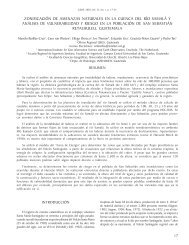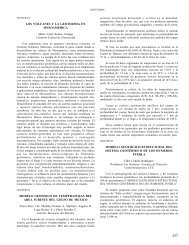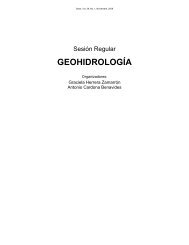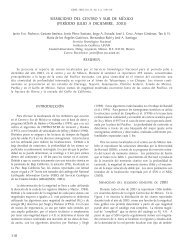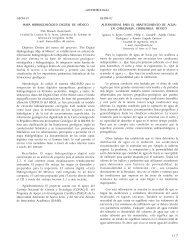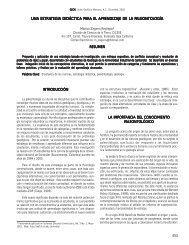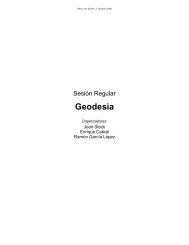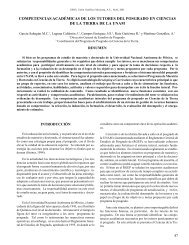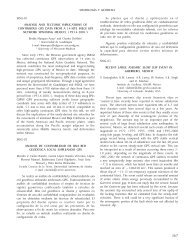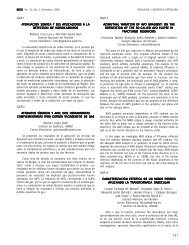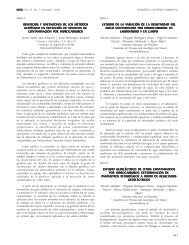Libro de resúmenes [revisión final, 172 páginas] - UGM
Libro de resúmenes [revisión final, 172 páginas] - UGM
Libro de resúmenes [revisión final, 172 páginas] - UGM
Create successful ePaper yourself
Turn your PDF publications into a flip-book with our unique Google optimized e-Paper software.
Geos, Vol. 27, No. 1, Octubre, 2007ESTUDIOS GEOLÓGICOS Y GEOFÍSICOS DE RIESGOS NATURALESal aplicar proyectos con la <strong>final</strong>idad <strong>de</strong> reducir la vulnerabilidadsísmica en edificios hospitalarios, mediante una metodologíaque incluye una secuencia <strong>de</strong> evaluación <strong>de</strong> parámetros quenos proporcionan la vulnerabilidad sísmica encontrada en dichosinmuebles, así como las perdidas esperadas en el acervo y flujos,dando a conocer las ventajas <strong>de</strong> aplicar la metodología planteaday posibles costos <strong>de</strong> inversión en la construcción y rehabilitación<strong>de</strong> estas instituciones en caso <strong>de</strong> ser afectadas por un sismo,<strong>de</strong>jando en evi<strong>de</strong>ncia las perdidas económicas que resultarían <strong>de</strong>no aplicarse este tipo <strong>de</strong> proyectos en hospitales, comparandoasí, no solo las <strong>de</strong>sventajas económicas, sino también losbeneficios <strong>de</strong> su aplicación, con el objetivo <strong>de</strong> promover mayoresprogramas presupuestarios en lo centros hospitalarios para laaplicación <strong>de</strong> metodologías <strong>de</strong> mitigación <strong>de</strong> vulnerabilidad antela amenaza sísmica.Lo anterior se concreta mediante la propuesta <strong>de</strong> una cédulaevaluatoria en la que se <strong>de</strong>sglosa el valor <strong>de</strong>l hospital tomandoen cuanta las diferentes partidas que compone las principalesvariables ( Elementos estructurales, No estructurales) que seencuentran en el edificio, para que una vez localizados loselementos <strong>de</strong> vulnerabilidad se pueda estimar el daño esperadoen cada partida y po<strong>de</strong>r priorizar las acciones <strong>de</strong> acuerdo a losresultados que arrojen mayor riesgo para la vida <strong>de</strong> los ocupantes;así como <strong>de</strong> mayores perdidas económicas esperadas. A<strong>de</strong>másla cédula muestra la representación económica que cadaproblemas <strong>de</strong>tectado en el inmueble pue<strong>de</strong> significar en perdidaal acervo, así como su representación en sus flujos, evi<strong>de</strong>nciandoel <strong>de</strong>merito económico que sufre el edificio por la vulnerabilidad<strong>de</strong>tectada.SE02-31 CARTELANOMALOUS GEOMAGNETIC VARIATIONSASSOCIATED WITH PARKFIELD (MS=6.0,28-SEP-2004, CALIFORNIA, USA) EARTHQUAKEKotsarenko AnatoliyCentro <strong>de</strong> Geociencias, UNAMkotsarenko@geociencias.unam.mxIn the present paper we present analysis of the ULF (Ultra LowFrequency) data measured at Parkfield (PRK) magneto-telluricstation (fluxgate instrument, 3 magnetic and 2 dipoles per 2electric components) for the period 1 week before – 1 day afterthe major EQ (EarthQuake, Ms=6.0, 28-SEP-2004, 17:15:24)occurred near Parkfield, California, USA.Spectral analysis reveals the ULF geomagnetic disturbancesobserved the day before the event (Sep 27, 15:00-20:00 UT), andat the day of the EQ (Sep 28, 11:00-19:00). Estimation of theperturbed signal amplitu<strong>de</strong>s gives the following values (frequencyband f = 0.25-0.5 Hz): up to 20 pT for the magnetic channels and1.5 mkV/km for the telluric ones.Observed phenomena occurs un<strong>de</strong>r quiet geomagneticconditions (#Dst#< 20 nT); revision of the referent geomagneticstations data situated far away from the EQ epicenter (>300##) does not reveal any similar effect. Moreover, the QuakeFin<strong>de</strong>r research group received very similar results (ELF rangeinstrument, situated about 50 km from the EQ epicenter) forthe day of the EQ. Comparative analysis of the mentioned 2stations shows that we observed the lower-frequency part of themassive ULF-ELF burst, localized in the frequency range 0.25-1Hz, generated 9 hours before the earthquake. Theoretical mo<strong>de</strong>lfor the generation mechanism of the observed phenomenon ispresented (\"A possible mechanism of modulation of intensity ofAlfvén resonances at the Earth’s surface before earthquakes\",session \"Física Espacial\", Cartel).The authors are grateful to M.Johnston for providing us with theParkfield Site data and to Peter Chi for referring McMAC data.SE02-32 CARTELGEOMAGNETIC ANOMALIES OBSERVEDAT VOLCANO POPOCATEPETL, MEXICOKotsarenko Anatoliy 1 , Grimalsky Vladimir 1 , Yutsis Vsevolod 2 ,Pérez Enríquez Román 1 , Koshevaya Svetlana 3 , LópezCruz Abeyro José Antonio 1 y Valdés González Carlos 41 Centro <strong>de</strong> Geociencias, UNAM2 Facultad <strong>de</strong> Ciencias <strong>de</strong> la Tierra, UANL3 Universidad Autónoma <strong>de</strong>l Estado <strong>de</strong> Morelos4 Instituto <strong>de</strong> Geofísica, UNAMkotsarenko@geociencias.unam.mxThe results of the ULF geomagnetic monitoring of the volcanoPopocatepetl (Mexico) and their analysis are summarized andpresented for the period 2003-2006. Our analysis reveals someanomalies, which are consi<strong>de</strong>red to be generated by localvolcanic origin: the EM background in the vicinity of the volcanois significantly noisier than in other reference stations; thesporadic strong noise-like geomagnetic activity observed in theH-component; some geomagnetic pulsations observed only at theTlamacas station (located at 4 km near the volcano). The resultsare discussed within presented physical mechanisms, furtherperspective directions to study volcanic geodynamical processesbesi<strong>de</strong>s the traditional ones are given.SE02-33 CARTELCONSTRUCCIÓN DE UN MDE CON DATOSSRTM Y CURVAS DE NIVEL DEL INEGIPARA SU USO EN ATLAS DE RIESGOCamarena García Miguel Alberto 1 y Suárez Plascencia Carlos 1 y 21 Departamento <strong>de</strong> Geografía y Or<strong>de</strong>naciónTerritorial, Universidad <strong>de</strong> Guadalajara2 División <strong>de</strong> Ciencias <strong>de</strong> la Tierra, CICESEmacg670729@gmail.comLa cartografía <strong>de</strong>l Instituto Nacional <strong>de</strong> Estadística Geografíae Informática (INEGI), presenta omisiones, tanto en productosimpresos como en digitales, como es la falta <strong>de</strong> curvas <strong>de</strong> nively su continuidad, la frontera tierra-agua no está correctamente<strong>de</strong>finida en la parte continental como insular y también se hai<strong>de</strong>ntificado <strong>de</strong>splazamiento entre los limites <strong>de</strong> cartas a escalasregionales.Del mo<strong>de</strong>lo vectorial <strong>de</strong>l INEGI se construye el Mo<strong>de</strong>lo Digital<strong>de</strong> Elevación (MDE), pero al tener omisiones que crean “huecos”,se busco como solucionarlas a través <strong>de</strong>l uso y elaboración<strong>de</strong>l Mo<strong>de</strong>lo Digital <strong>de</strong> Elevación Híbrido MDEH), que utilizalos datos <strong>de</strong> altura proporcionados por el Radar <strong>de</strong> la MisiónTopográfica <strong>de</strong>l Transbordar Espacial o THE SHUTTLE RADARTOPOGRAPHY MISSION (SRTM). Los mo<strong>de</strong>los digitales <strong>de</strong>elevación generados por el SRTM son una fuente importante<strong>de</strong> información <strong>de</strong>l relieve terrestre, sin embargo, tiene tresimperfecciones intrínsecas al método: a) Existen regiones con161


![Libro de resúmenes [revisión final, 172 páginas] - UGM](https://img.yumpu.com/51565067/161/500x640/libro-de-resamenes-revisian-final-172-paginas-ugm.jpg)
